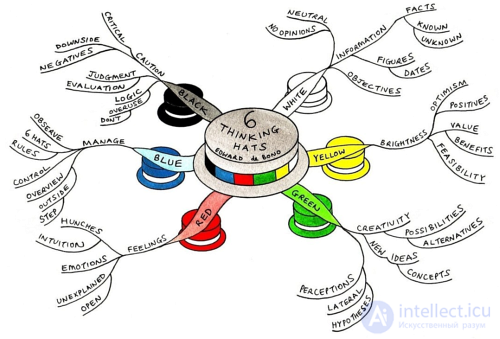Lecture

Six Thinking Hats is an Edward de Bono technique that allows you to structure and make collective and personal intellectual work much more efficient.
At the heart of the Six Hats is the idea of parallel thinking. Traditional thinking is based on controversy, discussion and collision of opinions. However, with this approach, often not the best solution wins, but the one that is more successfully promoted in the discussion. Parallel thinking is thinking in which different points of view and approaches do not collide, but coexist due to their separation in time (for example, in one period of time all participants in the meeting express the advantages of a new idea, in another - disadvantages, in the third - the idea that how to overcome disadvantages and what can be improved, etc.).
Usually, when we try to think about solving a practical problem, we face several difficulties. Firstly, we are often not at all inclined to think about a decision, instead limiting ourselves to the emotional reaction that predetermines our further behavior. Secondly, we are insecure, not knowing what to do or where to start. Thirdly, we try to simultaneously keep in mind all the information related to the task, be logical, make sure that our interlocutors are logical, be creative, be constructive and so on, and all this usually causes nothing but confusion and confusion.
The six-hat method is a simple and practical way to overcome such difficulties by separating the thinking process into six different modes, each of which is represented by a hat of its own color.
In full-color printing, colored dies are rolled one by one, overlapping each other, and at the output we get a color picture. The six hats method suggests doing the same for our thinking. Instead of thinking about everything at the same time, we can learn to operate with different aspects of our thinking in turn. At the end of the work, all these aspects will be brought together and we will get “full-color thinking”.

Sixth Hats Mental Map (Paul Forman)
The Edward de Bono method is based on the concept of parallel thinking. As a rule, a decision is born in a clash of opinions, in discussion and controversy. With this approach, preference is often given not at all to the best of options, but to the one that was more successfully promoted in polemics. In parallel thinking (constructive in essence), different approaches, opinions and ideas coexist, rather than oppose and do not collide.
Six hats of thinking, in the process of solving practical problems, help to cope with three main difficulties:
The 6 hats thinking method helps to overcome these difficulties by dividing the thinking process into six different modes, each of which is presented in the form of a metaphorical hat of a certain color. Such a division makes thinking more focused and sustainable and teaches us to operate with its various aspects in turn.
The following is a summary of the features and principles of using six hats.

White hat is used to direct attention to information. In this mode of thinking, we are only interested in facts. We ask questions about what we already know, as well as what other information we lack and how to get it.

In the red hat mode, participants in the session have the opportunity to express without explanation their emotions and intuitive guesses about the issue in question, so as to relieve tension, it is better to be aware of their attitude to the problem and report it to others. A red hat usually gives about 30 seconds.

Black hat allows you to give free rein to critical assessments, fears and caution. It protects us from reckless and ill-considered actions, indicates possible risks and pitfalls. The benefits of such thinking are certain, unless, of course, they are abused.

The yellow hat requires us to switch our thinking to a constructive direction, paying attention to the search for the merits, advantages and positive aspects of the considered idea or problem.

Being under a green hat, we invent new ideas, modify existing ones, look for alternatives, explore opportunities, in general, give creativity a green light.

The blue hat (“hat of hats”) differs from other hats in that it is intended not to work with the content of the task, but to control our thinking itself, the work process itself. In particular, it is used at the beginning of the session to determine what is to be done, and at the end to summarize what has been achieved and to identify new goals.
In group work, the most common model is the definition of the sequence of hats at the beginning of the session (under the blue hat). During the session, all participants simultaneously put on hats of the same color, according to a certain sequence, and work in the appropriate mode. The moderator stays under the blue hat and monitors the process of work, not allowing participants to use thinking techniques not characteristic of the current hat. Session results are summarized at the end under the blue hat.
The sequence of hats is of great importance and is determined on the basis of the problem to be solved (for more information about this you can learn at the training on “Six Hats”). For example, to create ideas , the sequence “blue - red - white - green - red - blue” is often used):
Some studies suggest that in different modes of brain functioning (criticism, emotions, creativity) its biochemical balance is different. If this is so, then some kind of system like six hats is simply necessary, since there can not be one “biochemical recipe” for optimal thinking.
"Six Hats" can be used for any mental work in a variety of areas and at various levels. On a personal level, these can be, for example, important letters, articles, plans, problem solving. In single work - planning, evaluation of something, design, creation of ideas. In group work - meeting, assessment and planning, conflict resolution, training.


The use of six hats of thinking is reasonable for any mental work, in any field and at various levels. For example, in personal terms, this could be writing a business letter, planning important affairs, evaluating something, solving the problem of getting out of a difficult life situation, etc. When working in a group, the 6 hats thinking method can be viewed as a type of brainstorming method, it can also be used in resolving disputes and conflicts, again in planning and evaluating, or it can be used as part of a training program.
By the way, many international corporations, such as British Airways, IBM, Pepsico, DuPont and many others, have long adopted this method.
+ Thinking activity for most people is an abstract, boring and boring job. The six-hat method is able to captivate and make mental activity colorful and interesting. In addition, the six colored hats are a pretty memorable expression and easily digestible and applicable technique that can be used both on boards of directors and in kindergartens.
+ The 6 hats method recognizes significance and pays attention to all aspects of working on a solution — facts, emotions, pros and cons, generating fresh ideas.
The statement by Kozma Prutkov, “ A narrow specialist is like a flux: its fullness is one-sided, ” well illustrates this plus of the method of 6 hats of thinking. The drawback of specialized experts is that they are always in the same hat, and these “fluxes” interfere with each other in finding the right solution. A method of six hats directs the discussion in the right direction. For example, it helps to neutralize a participant who is prone to excessive criticism. Having understood the principle of the six-hat technique, the critic will no longer arbitrarily kill ideas with his comments and will save his ardor, since he will know that it will soon be his turn to wear a black hat.
+ The human mind, guarding its integrity and self-sufficiency, often takes everything new for something unnatural and false. Using the method of de Bono, we get the opportunity to consider opinions about things that we have not taken seriously before. This increases the chances of finding the right or appropriate solution to the situation.
+ With the help of this technique we get the opportunity to agree with the interlocutor, ask the participant to be more compliant and distract from personal preferences, recommend him not to follow everyone, expand the flow of his thoughts 180 degrees or you can just give a person a chance to express everything that he "boiled." Thus, you do not just give a person the opportunity to speak, but simplify the search for a joint solution.
+ The method of 6 hats allows us to bring to the discussion topics that are usually shy and taciturn people. At the same time, any of the participants expressing their point of view does not feel discomfort in spite of the fact that his opinion may contradict the opinion of the majority, because he, as it were, speaks on behalf of one of the colored hats, and not on his own behalf.
+ Thanks to the clearly marked work structure, which excludes empty talk, thinking becomes more concentrated, rational and fruitful.
+ As a result of the fact that when using the reception of six hats, the polar points of view do not conflict with each other, but coexist peacefully and complement each other, new extraordinary and innovative thoughts and ideas are born.
+ Another advantage of the six hats of thinking is that with the help of this method we learn to manage our attention. After all, if our mind is not only able to react to events happening to us, but is ready to switch from something one to another, and at the same time can view the object from six sides, it develops our attention and makes it much sharper.
+ According to Edward de Bono’s deep conviction, which he described in detail in his book, the six thinking hats are designed to serve as conditioned reflex signals that can affect the balance of chemical elements (neurotransmitter ratios) in the brain.
- The main disadvantage of 6 hats of thinking, although, probably, not even a minus, but the complexity is the technology of the six hats, i.e. In order to master this technique and usefully learn how to apply it, it is necessary for some time. It is easier to solve issues using the reception of six hats individually, but in a team it is much more difficult to do.
- If you are not the immediate supervisor, initiating this method in the enterprise and explaining all its advantages is not an easy task. The majority of domestic enterprises are not ready to introduce any innovations in the work of the company, in particular collective methods, and in particular, requiring personal involvement.
- In addition to the need to convince management of the need for this method, there is also a moment of the seriousness of its perception directly by the team. Someone may consider him “childish” and refuse to try on colored hats (although you don’t need to wear any hats), explaining that he is not a clown. However, it is again a matter of professionalism of the presenter (moderator, i.e. blue hat).
To level a few cons of the technology of six hats and It is important to thoroughly study all the rules for carrying out this technique of thinking before starting a collective fitting of hats.

With collective participation, the de Bono method implies the presence of a moderator who manages the process and ensures that it does not turn into a farce. All the time, being under a blue hat, the moderator records everything said on paper and finally summarizes the results obtained (to summarize the results and visualize it, it is better to use the intellect cards, learn how to compile them by reading the article “Rules for Compiling Mental Maps”.
At the beginning, the presenter briefly introduces the team to the general concept of the six hats of thinking, then indicates the problem or task. Well, for example: "A rival firm has offered cooperation in the field ... What to do?".
The session begins with everyone taking part in it “putting on a hat” of the same color, and looking at the situation with a look at the situation, in the perspective corresponding to this hat. The order of fitting hats, in principle, does not play a huge role, however, a certain order is still necessary. Try using the following option:
Start a discussion on a topic in a white hat, that is, collect and consider all the available facts, figures, statistics, proposed conditions, etc. After all the available data discuss in a negative way, i.e. in a black hat, and even if the offer is profitable, a fly in the ointment, as a rule, is always there. Its what you need to see. Next, find all the positive points in cooperation, wearing a positive yellow hat.
After reviewing the question from all sides, and gathering enough information for further analysis, wear a green, creative hat. In it try to find something new, going beyond the existing proposals. Strengthen the positive moments, smooth the negative. Let each participant suggest an alternative path. New ideas are analyzed again in a yellow and black hat. Yes, and do not forget to periodically give participants to let off steam in a red hat (they wear it rarely and for a rather short period of thirty seconds, not more). So trying to put on six hats of thinking in different sequences, with time, you can determine the most appropriate sequence.
At the end of the collective parallel thinking moderator sums up the work done. It is also important that the moderator ensures that participants do not wear several hats at the same time. Thus, thoughts and ideas are not intertwined and confused.
You can use this method in a slightly different way - let each participant put on a hat of a certain color and play a role.In this case, it is better to distribute hats in such a way that they do not correspond to the type of person. For example, let the optimist put on the black one, the yellow one who constantly criticizes everything, let everyone who is not used to expressing emotions take turns red, and let us not try on the main creative, etc. This will enable participants to unlock the potential.
Comments
To leave a comment
General psychology
Terms: General psychology